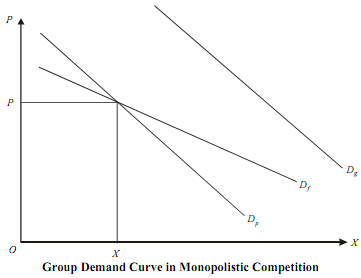General approach to equilibrium:
As we defined earlier the grouped demand curve (demand) curve of the products which are close substitutes of each other) is negatively sloped. This grouped demand curve must somehow be divided up among the members of the group. All the firms in the group are identical, facing similar demand and cost conditions. If all charge the same price, they will have identical market shares.

In the figure above, Dg is the grouped demand curve and Dp is the proportionate demand curve (when all the firms charge the same price). Dp is obtained horizontally dividing Dg by the number of firms. A firm, however, does not perceive Dp to be its demand curve. If the current price is P , and quantity is X, then the firm perceives its curve as Df. Note that Df is more elastic than Dp. It is actually the demand curve of the firm if all of the rest continue to charge the same price. Df is more elastic because if one firm reduces it's prices and others do not, then the firm will be able to sell more than its market share (given by Dp). Similarly, if a firm charges higher prices while others do not, it will be able to sell less than what is given by Dp.
In monopolistic competition, there are a large number of firms and therefore each firm thinks that its price changes will go unnoticed. That is why firms behave naively.